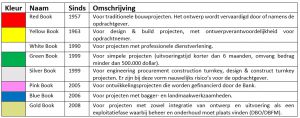Contracts for international projects
FIDIC contracts are currently the most common standard for international construction projects worldwide. The FIDIC contract formats are popular for large-scale and smaller construction projects, and are suitable for parties:
- Of different nationalities
- Speaking different languages
- Hailing from different jurisdictions.
FIDIC, since 1913
Fédération International des Ingénieurs Conseils (FIDIC) was established in 1913 as an international organisation of engineering agencies. Today FIDIC has over a hundred members worldwide.
The Netherlands represented by Koninklijke NLingenieurs.
The Netherlands is represented by Koninklijke NLingenieurs (royal Dutch engineers), one of the promotors of the DNR, a Dutch regulation aimed at the establishment of unambiguous construction agreements. You can read more about the DNR, the role of Koninklijke NLingenieurs and the features and benefits of ISO 29481 here.
FIDIC: 100 years older than the DNR
The organisation FIDIC is exactly one century older than the most recent form of the DNR, which is dated 2013. Yet, I imagine that many Dutch project workers are still unfamiliar with FIDIC. Of course, the more international project manager will have worked on a FIDIC project. And no doubt, some contracting managers will have applied their UAV-GC 2005 project experience in a FIDIC project. Apart from these limited experiences, we should realise that FIDIC exists ‘by the grace’ of globalisation and internationalisation of construction projects. And there was not a lot of that happening back in 1913.
FIDIC books
FIDC Red Book: construction for building and engineering works
The first FIDIC contract form, known as the FIDIC Red Book, was published in 1957. This first edition was based on a national contract, derived from the ICE Conditions of Contract as published by the Institution of Civil Engineers. The FIDIC Red Book is intended for traditional construction projects. The design was created by or on behalf of the client.
FIDIC Yellow Book: plant and design-build
The second type of FIDIC contract was published in 1963. This is the FIDIC Yellow Book. It is a standard contract, with the contractor being responsible for the design. The FIDIC Yellow Book is used for design-build projects where the contractor has responsibility for the design.
Internationalisation of construction industry drives FIDIC
In the late 1960s and early 1970s, an important development followed. An increase in construction projects in the Middle East spurred an even greater need for international contract formats. Because of the different nature and type of these international construction projects, the FIDIC Red Book and FIDIC Yellow Book were no longer sufficient. In response, FIDIC published a series of contract models to meet this international need. This meant an expansion of the book series and the colour palette.
FIDIC White Book: professional service provision
The FIDIC White Book – or the Client/Consultant Model Services Agreement – has become another important and well-known part of the FIDIC contract suite. In 1990, four years after the initial words were drafted, the first version of the book was printed and published. The FIDIC White Book is one of the most commonly used formats of international contracts for professional service provision.
FIDIC Green Book: small and short-term projects
The FIDIC Green Book is one of the lesser known FIDIC contract models. The design of this contract, meant to serve relatively small projects of a repetitive or short-term nature, is relatively simple. Here, it is the client who creates the design. According to FIDIC guidelines, the FIDIC Green Book is intended for projects with a budget up to US$500,000 and a maximum 6-months duration. The first version of the FIDIC Green Book was published in 1999.
FIDIC Silver Book: EPC/turnkey projects
The FIDIC Silver Book was also published in 1999. The FIDIC Silver Book is used for EPC/turnkey projects where the contractor is responsible for the design and most of the risks. These important changes to original FIDIC contracts were made in response to construction trends of the 1990s.
FIDIC Pink Book: bank-funded development projects
This was followed by a change to the FIDIC Red Book in 2005, which led to the publication of the FIDIC Pink Book of the Multilateral Development Bank (MDB). This book was devised to be used for development projects financed by banks.
FIDIC Blue Book: dredging projects
The lesser-known FIDIC Blue Book was first published in 2006. It was drawn up for dredging and land development activities. In most cases the client is responsible for the design. The most important part of the FIDIC Blue Book is the description of the activity and operations, which are minutely defined and included in the specifications, drawings and design of the work.
FIDIC Gold Book: DBO and DBFM projects
Finally, the first edition of the FIDIC Gold Book saw the light in 2008. This FIDIC contract is based on a typical design and build contract form, including a period of management and maintenance. The FIDIC Gold Book comprises a complex array of various services and is intended to be used for long-term partnership projects of at least 20 years.
There are no less than eight different colours to choose from
As described, the FIDIC contract formats – or FIDIC books – cover the entire spectrum of duties and responsibilities in various types of projects. The different books are indicated with a colour:

FIDIC Rainbow Suite: diversity and inclusion
The FIDIC Red, Yellow and Silver Books were published as one volume in September 1999. This joint publication is known as the FIDIC Rainbow Suite. The FIDIC 1999 Rainbow Suite was translated in a number of languages, in an attempt to prevent issues with unauthorised and inaccurate translations. The FIDIC 1999 Rainbow Suite has been translated to:
- Arabic
- Chinese
- French
- Polish
- Portuguese
- Romanian
- Russian
- Spanish
- Turkish
More recently, FIDIC has published the FIDIC 2017 Rainbow Suite (Red, Silver & Yellow book). The main objective of this new serie is to increase contract clarity and security. The changes compared to the Rainbow Suite 1999 should lead to fewer disputes and more successful projects.
To FIDIC, or not to FIDIC?
More options lead to a more deliberate choice. A more deliberate choice can result in fewer disputes and more successful projects. However, for a project with predominantly Dutch participants, the Dutch contract forms Construction team, DNR, UAV or UAV-GC will suffice. We have published various blogs about these contract models. Read them to find out which format matches best with your project.
FIDIC contracts are particularly designed for projects with an international character. As this international aspect is not always obvious for every project, it helps to know the differences and similarities between the FIDIC and, for example, the UAV-GC.
FIDIC and UAV-GC: similarities and differences
One example relates to changes to the model basic agreement of the UAV-GC 2005 contract; for each project, this text must be adapted to the selected contract and tendering form. In contrast, the FIDIC terms and conditions do not prescribe these changes by the client. However, certain details of a FIDIC contract need to be adapted to local law. The FIDIC Silver Book, for example, by default follows different regulations on the right of retention than Dutch law prescribes.
A notable difference between the FIDIC books and the UAV-GC is that the latter explicitly and repeatedly mentions application of reasonableness and fairness. However, in the case of contracts where this is not explicitly stated, Dutch law still applies. Therefore, FIDIC contracts in the Netherlands basically apply the same principles of reasonableness and fairness as the UAV-GC.
A small, but significant difference
We can conclude that within that contractual and legal context, FIDIC contract forms can be considered as secure in the Netherlands as well. They have proven their worth in practice. International parties are familiar with FIDIC and are keen to use the formats. Unlike the contractors however, Dutch clients are not always aware of the existence of these FIDIC contract models. For many projects that might just be a missed opportunity. A procurement strategy involving more and different types of contract formats generates more choice, which would also benefit Dutch parties and projects.
Faith in FIDIC
FIDIC contracts are gaining popularity in the Netherlands. The large number of comprehensive international projects, ever-growing competition and internationalisation are the drivers of this development. As a consequence, English is increasingly used as the working language for projects in the Netherlands. If these increases in competition and internationalisation continue, it is likely that application of the FIDIC contract suite will grow correspondingly in years to come.
The FIDIC Silver Book, for example, can be an appropriate contract format for complex and specialist projects commissioned by national and provincial authorities. It helps reduce client risk (similar to the Dutch UAV-GC 2005) and further stimulates competition among national and international contractors.
The FIDIC Yellow Book then, is very suitable for the supply of wind turbines, as part of the development and construction of a wind farm. This type of contract fits well with the working method, risks and level of complexity associated with the supply and construction of wind turbines and is known by all wind turbine suppliers. In this respect, the FIDIC Yellow Book has a green touch in the Netherlands. After all, the projects using this contract format tend to focus on the generation of renewable energy.
Alfamail: ISO 29481 with a mission
Alfamail is excited to contribute to such sustainability projects. From day 1, our mission has been to not only focus on ourselves, but on our outside world as well. We believe that knowledge is key to making better decisions in terms of sustainability and beyond.
Alfamail: Software-as-a-Service (SaaS) with a mission
So how do we contribute? We do not build windfarms, nor do we write contracts. What do we do instead? We build ISO 29481 software and write ISO 29481 frameworks. This enables projects using the FIDIC Yellow Book to exchange and archive all formal contract communications in a digital and sustainable way. And yes, our Alfamail ISO 29481 software is available in English and we have English-language ISO 29481 frameworks, including one that is based on the FIDIC Yellow Book.
The FIDIC Yellow ISO 29481 framework
The Alfamail FIDIC Yellow ISO 29481 template is based entirely on FIDIC Yellow. All formal transactions between various roles are defined in the standard FIDIC Yellow ISO 29481 framework.
FIDIC Yellow roles
The roles describe who is responsible for what. FIDIC Yellow at least defines:
- Contractor;
- Employer;
- Engineer.
FIDIC Yellow transactions
The range of duties in FIDIC Yellow is reflected in the available transactions. The transactions provide insight into the various duties in the FIDIC Yellow for each person and project. Based on FIDIC Yellow these duties include at least the following:
- Tests on completion (FIDIC Yellow, Chapter 9)
- Variations and adjustments (FIDIC Yellow, Chapter 13)
- Contract price and payment (FIDIC Yellow, Chapter 14)
- Employer’s and contractor’s claims (FIDIC Yellow, Chapter 20).
In short, this FIDIC Yellow ISO 29481 template offers a ready-made starter pack to apply ISO 29481 in line with FIDIC Yellow. A toolbox or toolkit, so to speak. And the manual? As Heston Blumenthal would say: “It’s a three-stage process”:
- Step 1: Subscribe to Alfamail ISO 29481 software
- Step 2: Allocate project roles
- Step 3: Schedule a joint training
Do you have it in another colour?
Of course, we can help if you need ISO 29481 for another FIDIC colour, like Red or Silver. Please contact our consultants today and challenge them to set up your tailored ISO 29481 framework with you.
FIDIC Yellow and ISO 29481: the vision for international projects
Do you want to learn more about ISO 29481 for projects with FIDIC Yellow? Please check our webpage on the FIDIC Yellow ISO 29481 template. If you want to, you can get cracking with ISO 29481 for FIDIC Yellow projects straight away. Select download the role chart and add diversity and colour to your project with ISO 29481 and FIDIC.




